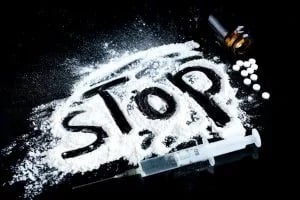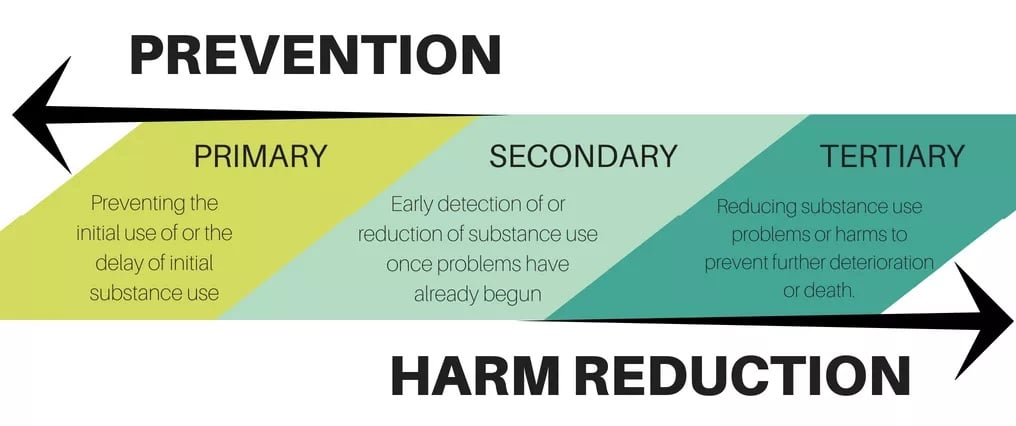Abstinence vs. Harm Reduction: The debate in the addiction treatment community
Harm reduction has been among the most hot-button, controversial topics out there ever since its inception, and it doesn’t seem to be relinquishing its place any time soon. It goes head-to-head with everything that the nearly century-old traditional, abstinence – based treatment believes in. The question remains to be answered and the conversation continues: harm reduction vs. abstinence. Can harm reduction yield lasting positive results for the substance-using population? In this article we will explore harm reduction’s definition and practical applications, pros and cons, and future in the world of substance abuse.
What is Harm Reduction?
As defined by the Substance Abuse and Mental Health Administration, “Harm reduction is an approach that emphasizes engaging directly with people who use drugs to prevent overdose and infectious disease transmission, improve the physical, mental, and social wellbeing of those served, and offer low-threshold options for accessing substance use disorder treatment and other health care services.”1
Simply put, harm reduction refers to programs, policies and practices that aim to reduce the negative physical, legal, and social consequences associated with drug and alcohol abuse. It chooses to shift the focus away from the problematic behavior itself to its harmful consequences, and instead deal with those consequences through initiatives that enable more safe, moderate, and responsible substance use. The core principle of harm reduction is meeting the person where they are at and encouraging and supporting each step in the right direction, regardless how small. It is based on the understanding that not all substance users are ready or willing to engage in substance abuse treatment, and the belief that the traditional “total abstinence” approach does not decrease drug use or consequences.

What Services are Offered Under Harm Reduction?
The harm reduction movement includes a number of health/ safety and social services and programs, all of which are aimed at enabling individuals to use their substance of choice in a safe, healthy, and responsible manner. These services include:
- Needle and syringe exchange programs
Harm reduction needle exchange programs allow injecting drug users to safely dispose of their used syringes and obtain new, sterile ones to ensure safe and uncontaminated drug injection.
- Safe consumption/ injection sites
Safe consumption sites are designated, supervised spaces which allow people to ingest their drug of choice while in a safe environment, using sterile equipment, under qualified medical supervision.
- Drug checking (e.g., fentanyl test strips)
Drug checking enables drug users to test the purity of their drugs before ingestion, and thus prevent overdose.
- Overdose prevention and reversal education
Overdose education teaches drug users and their families and friends to recognize the telltale signs of a drug overdose and respond appropriately and in time. It also encompasses training on how to administer Naloxone/ Narcan.
- Naloxone (Narcan) distribution
Naloxone is a drug which effectively reverses overdoses caused by opioids and is most widely distributed and used in its nasal spray form (known as Narcan).
- Safer relations education and kit distribution
Harm reduction programs educate pre-teens, teens, and adults alike on the risk of unprotected relations, diseases spread by these risky behaviors, and distribute kits containing paraphernalia necessary for safe relations – like condoms, birth control, and HIV/ AIDS test kits.
- HIV/ AIDS education and testing
Advance education and periodic testing can greatly reduce the risk of contraction and transmission of HIV/ AIDS, a debilitating bloodborne disease spread by unsafe injection practices and unprotected relations.
- Distribution of pre- and post-exposure prophylaxis
Pre-and post-exposure prophylaxis are medications that can be taken before and after exposure to the bodily fluids of a HIV/ AIDS infected individual, which reduce the chances of contracting the disease.
- Non- abstinence-based housing
Some harm reduction programs offer free housing minus the no-substances policy, granting shelter to homeless people despite their substance use.
- Health screenings
Periodic health screenings help drug-using individuals remain on top of their overall health and provide opportunities to link them with appropriate care if needed.
- Pregnancy testing and linkage to prenatal care
Periodic pregnancy testing enables early detection of pregnancy, and referral to proper prenatal care.
- Safe disposal of used drug equipment
Many needle exchange programs and safe consumption sites offer safe disposal of sharps and any used drug paraphernalia, preventing secondhand use and the spread of disease.
- Referrals to treatment and critical health services2
Once individuals become associated with a harm reduction site, the workers present can refer them to appropriate healthcare and substance abuse services.
Recently, as part of its larger harm reduction plan, SAMHSA has allocated $10 million to be distributed to harm reduction programs between 2022 and 2025. The grant funds are authorized to be used for the following services and supplies as well as harm reduction training:
Principles of Harm Reduction
Harm reduction is based on a number of steadfast principles:
- A non-judgmental approach should always be taken when dealing with individuals suffering from SUD.
- All individuals – regardless of race, religion, color, or past choices – deserve to be treated with dignity, compassion, and humility.
- Substance use disorder is a disease like any other, and the stigma surrounding it must be combated.
- Evidence-based policies and practices should always be used in substance use disorder treatment.
- Behavioral change is a slow, incremental process.
- Substance use policies and practices should be formed with the direct involvement of the substance-using community.
- The focus of treatment should be improvement of quality of life, not abstinence.
- We are committed to universal human rights.
- The using individual should be empowered as the primary party responsible for reducing the harms caused by their substance use.
These beliefs shape the policies and initiatives created by the harm reduction movement.
What is The Goal of harm reduction?
The main objective of harm reduction is to save lives and protect the health of substance users, their families, and their communities, and encourage positive change in their lives – however incremental. Harm reduction seeks to keep drug users alive, and as healthy as possible, so that they may eventually seek treatment and perhaps recover.
Another goal of the harm reduction movement is to reduce the harms of national and international drug laws and policy. Harm reduction activists believe that many drug laws are racial, stigmatizing and ultimately harmful, and they seek to reform them as much as possible. Such policies include the criminalization of drug use, so- called “abusive” law enforcement practices, denial of medical care, restrictions on possession of drug paraphernalia, mandatory urinalyses, and discrimination based on drug use, class, race, and gender.
A third aim of the harm reduction movement is to offer alternatives to total abstinence and prevention – based approaches. Harm reduction activists believe that not every substance abuser is ready or willing to seek treatment and offering them options that do not require them to abstain from their substance of choice is a critical step to getting them the help they need. 3

Abstinence vs. Harm Reduction: The Debate
Abstinence and harm reduction stand as the foremost two methods in the field of substance abuse treatment, and the debate rages fiercely: Can harm reduction save lives? Which approach is most constructive? Let’s take a look at each.
Abstinence
Abstinence is defined as the complete cessation of drug or alcohol use. Long considered to be the most effective treatment for substance addiction, abstinence was used to break alcohol dependencies for centuries - way before addiction was recognized as a legitimate medical disease.
Abstinence, also known as the Minnesota Model, is based on ten fundamental principles:
- Addiction is an involuntary, primary, describable, and diagnosable disease.
- Addiction should be viewed as a chronic and progressive disease.
- There is no cure for addiction, but it can be managed through treatment and strong family and peer support.
- Residential addiction treatment does not determine the ultimate success of addiction treatment outcomes.
- Substance abuse treatment should be holistic and all-encompassing – addressing physical, mental, emotional, spiritual, and social health.
- Individuals suffering from substance use disorder should always be treated with dignity and respect.
- Addicts are highly vulnerable to mind- and mood-altering substances, and this vulnerability should be addressed in treatment.
- Addiction must be treated by a group of multi-disciplinary professionals, and ideal treatment should include closer and more informal relationships between client and staff.
- The most critical factor in treatment – the primary counselor – should be of a similar demographic to the client, and perhaps even in recovery themselves.
- A successful treatment program should incorporate strong involvement in an AA/ NA/ CA etc. community.

Almost all abstinence-based programs follow the 12 Steps, and include involvement in a recovery community such as Alcoholics Anonymous, Narcotics Anonymous, Cocaine Anonymous, Heroin Anonymous, and so forth. (The 12 Steps were actually conceived by Bill Wilson, a former AA member, in 1938, and eventually incorporated in the “Big Book” - the AA bible and primary text.) Contemporary abstinence programs blend the teachings of the 12 Steps with comprehensive physical and mental health care, intensive individual and group therapy, holistic experiences, community meetings, and strong family involvement throughout. Statistics show that the longer sobriety is maintained, the lower the chances of relapse fall.
Harm Reduction
In sharp contrast, harm reduction focuses exclusively on reducing the physical, social and economic harms of substance abuse without reducing the actual substance use – essentially allowing people to use “as safely and responsibly as possible”. This approach was popularized in the 1980s, in an effort to curb a growing HIV epidemic and other ravages wrought by addiction.
Similar but not identical to harm reduction is the principle of Moderation, which espouses the controlled and decreased use of substances. Moderation Management was created in the mid-90s by Audrey Kishline, an alcoholic who did not accept the principles and disease theory of the AA. By far the most controversial of all substance use treatment models, Moderation Management allows its members to consume their substance of choice in moderation – relying heavily on self-discipline, strong accountability, and self-tracking. It also rejects the need to submit to a higher spiritual power, which made it appealing to secular/ atheist substance users who were turned off by the seeming “imposed spirituality” of AA and the 12 Steps.
Yet another treatment model which does not incorporate total abstinence is prevention – programs and services which attempt to prevent or delay initial substance use as much as possible, through awareness and educative initiatives. Prevention and harm reduction naturally intersect, as is shown in their 3 stages of substance use treatment:
- Primary – Preventing/ delaying initial substance use (Prevention)
- Secondary – Early detection of or minimization of substance use once problems have begun (both)
- Tertiary – Reducing substance use problems or harms to prevent further deterioration or death (harm reduction)
The principles, goals, programs and services of the harm reduction movement have all been explained in the paragraphs above.

Abstinence vs. Harm Reduction – Pros and Cons
After learning about harm reduction, the question is almost glaring: Does harm reduction work? Unfortunately, it is nearly impossible to find an accurate success rate for either approach, since this sort of data is sourced mainly from the subjective self-reporting of clients. For example, AA’s success rate has been touted as anywhere between 5 to 70 percent; the same applies to most all abstinence-based programs. When it comes to harm reduction, the struggle to find a reliable success rate is only compounded by the fact that harm reduction has no clear definition of success, since that is dependent on each individual and what success means for them…
In an effort to clarify matters somewhat, let’s look at the basic pros and cons of both Abstinence and harm reduction.
Abstinence
Pros:
- Improves overall physical, mental, emotional, behavioral, and cognitive health
- Decreases mortality
- Decreases crime, violence, and legal issues
- Improves relationships
- Increases self-esteem and motivation
- Decreases spending and grants financial freedom
- Reduces risk of relapse
- Increases chances for sustained sobriety
- Increases employment opportunities
Cons:
- Depends strongly on a 12-Step Program
- Involves faith-based treatment
- Does not address “problem drinkers” who are not yet fully dependent on alcohol/ substances
Harm Reduction
Pros:
- Reduces costs (law enforcement, medical care etc.)
- Reduces spread of infectious diseases
- Prevents injuries and overdoses
- Opens the door to treatment and resources for those who are unwilling to pursue total abstinence
- Gives tools to those whose substance use is still manageable (e.g. problem drinkers)
Cons:
- Allows and further enables addicts to continue using/ drinking
- Increases accessibility (and consequently, demand and use) of substances and drug paraphernalia
- Does not end the cycle of addiction, leaving victims still suffering and struggling with their disorder
- Perpetuates all negative physical, emotional, and cognitive effects of substance abuse (since clients are still using as before)
- Conveys the false notion that there is a safe, responsible, and sustainable way of engaging in substance use
- Portrays substance use an inevitable and acceptable lifestyle
- Opens the door for increasingly liberal drug policies and drug law reform (e.g. drug legalization)
Abstinence vs. Harm Reduction: Conclusion
When answering the question “Abstinence or Harm Reduction?”, there are innumerable views, arguments, studies, and statistics both for and against. It’s exceedingly difficult to find an objective voice amidst the clamor, and more material is published each day, merely increasing the confusion.
Despite this, it is critical to understand one thing: Harm reduction is not, and never will be, harm elimination. Although the benefits of harm reduction cannot be ignored, problems arise when people begin mistaking a bandage for an eternal cure. Chronic substance use (regardless how safe and supervised) is and will always be dangerous and unsustainable; any program which seeks to enable substance use is rendering a deadly disservice to its clients. This is why harm reduction (alone) does not work.
That being said, there undoubtedly is a place for harm reduction in the world of addiction treatment. Harm reduction can play a crucial role as a stepping-stone to proper substance abuse treatment and therapeutic care. It can prove invaluable in keeping substance users as safe and healthy as possible until they feel ready to enter treatment, or in helping non-problematic occasional substance users make wise and educated choices when they use. Harm reduction with rehabilitation as an ultimate goal may just be a winning combination - but harm reduction alone is not a long-term solution.
Are you or a loved one struggling with a substance use disorder? There is always hope, and there is always help available for you. Avenues Recovery Center offers accredited drug and alcohol rehabilitation programs that will meet you where you’re at and help you live a rich, fulfilling substance-free life. Reach out to begin your journey home today!
Sources
[1] www.samhsa.gov
[2] www.chcs.org
[3] www.hri.global


